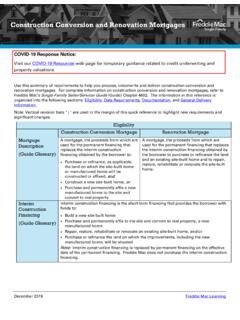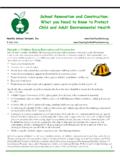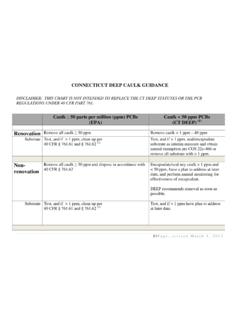Transcription of The Lead-Safe Certified Guide to Renovate Right
1 1-800-424-LEAD (5323) September 2011 Important lead hazard information for families, child care providers and FIRMLEAD-SAFETHE Lead-Safe Certified Guide TO RENOVATERIGHTThis document may be purchased through the Government Printing Office online at or by phone (toll-free): S THE LAW!Federal law requires contractors that disturb painted surfaces in homes, child care facilities and schools built before 1978 to be Certified and follow specific work practices to prevent lead contamination. Always ask to see your contractor s law requires that individuals receive certain information before renovating more than six square feet of painted surfaces in a room for interior projects or more than twenty square feet of painted surfaces for exterior projects or window replacement or demolition in housing, child care facilities and schools built b e fo re 1978 . Homeowners and tenants: renovators must give you this pamphlet before starting work.
2 Child care facilities, including preschools and kindergarten classrooms, and the families of children under six years of age that attend those facilities: renovators must provide a copy of this pamphlet to child care facilities and general renovation information to families whose children attend those SHOULD READ THIS PAMPHLET?This pamphlet is for you if you: Reside in a home built before 1978. Own or operate a child care facility, including preschools and kindergarten classrooms, built before 1978, or Have a child under six years of age who attends a child care facility built before will learn: Basic facts about lead and your health. How to choose a contractor, if you are a property owner. What tenants, and parents/guardians of a child in a child care facility or school should consider. How to prepare for the renovation or repair job.
3 What to look for during the job and after the job is done. Where to get more information about pamphlet is not for: Abatement projects. Abatement is a set of activities aimed specifically at eliminating lead or lead hazards. EPA has regulations for certification and training of abatement professionals. If your goal is to eliminate lead or lead hazards, contact the National Lead Information Center at 1-800-424-LEAD (5323) for more information. Do-it-yourself projects. If you plan to do renovation work yourself, this document is a good start, but you will need more information to complete the work safely. Call the National Lead Information Center at 1-800-424-LEAD (5323) and ask for more information on how to work safely in a home with lead-based paint. Contractor education. Contractors who want information about working safely with lead should contact the National Lead Information Center at 1-800-424-LEAD (5323) for information about courses and resources on Lead-Safe work , REPAIRING, OR PAINTING?
4 Is your home, your building, or the child care facility or school your children attend being renovated, repaired, or painted? Was your home, your building, or the child care facility or school where your children under six years of age attend built before 1978? If the answer to these questions is YES, there are a few important things you need to know about lead-based pamphlet provides basic facts about lead and information about lead safety when work is being done in your home, your building or the child care facility or school your children Facts About Lead Lead can affect children s brains and developing nervous systems, causing reduced IQ, learning disabilities, and behavioral problems. Lead is also harmful to adults. Lead in dust is the most common way people are exposed to lead. People can also get lead in their bodies from lead in soil or paint chips.
5 Lead dust is often invisible. Lead-based paint was used in more than 38 million homes until it was banned for residential use in 1978. Projects that disturb painted surfaces can create dust and endanger you and your family. Don t let this happen to you. Follow the practices described in this pamphlet to protect you and your AND YOUR HEALTHLead is especially dangerous to children under six years of age. Lead can affect children s brains and developing nervous systems, causing: Reduced IQ and learning disabilities. Behavior children who appear healthy can have dangerous levels of lead in their is also harmful to adults. In adults, low levels of lead can pose many dangers, including: High blood pressure and hypertension. Pregnant women exposed to lead can transfer lead to their fetuses. Lead gets into the body when it is swallowed or inhaled.
6 People, especially children, can swallow lead dust as they eat, play, and do other normal hand-to-mouth activities. People may also breathe in lead dust or fumes if they disturb lead-based paint. People who sand, scrape, burn, brush, blast or otherwise disturb lead-based paint risk unsafe exposure to should I do if I am concerned about my family s exposure to lead? A blood test is the only way to find out if you or a family member already has lead poisoning. Call your doctor or local health department to arrange for a blood test. Call your local health department for advice on reducing and eliminating exposures to lead inside and outside your home, child care facility or school. Always use Lead-Safe work practices when renovation or repair will disturb painted surfaces. For more information about the health effects of exposure to lead, visit the EPA lead website at or call 1-800-424-LEAD (5323).
7 There are other things you can do to protect your family every day. Regularly clean floors, window sills, and other surfaces. Wash children s hands, bottles, pacifiers, and toys often. Make sure children eat a healthy, nutritious diet consistent with the USDA's dietary guidelines, that helps protect children from the effects of lead. Wipe off shoes before entering the DOES THE LEAD COME FROM?Dust is the main problem. The most common way to get lead in the body is from dust. Lead dust comes from deteriorating lead-based paint and lead-contaminated soil that gets tracked into your home. This dust may accumulate to unsafe levels. Then, normal hand to-mouth activities, like playing and eating (especially in young children), move that dust from surfaces like floors and window sills into the body. Home renovation creates renovation activities like sanding, cutting, and demolition can create hazardous lead dust and chips.
8 Proper work practices protect you from the dust. The key to protecting yourself and your family during a renovation , repair or painting job is to use Lead-Safe work practices such as containing dust inside the work area, using dust-minimizing work methods, and conducting a careful cleanup, as described in this sources of lead. Remember, lead can also come from outside soil, your water, or household items (such as lead-glazed pottery and lead crystal). Contact the National Lead Information Center at 1-800-424-LEAD (5323) for more information on these YOUR HOME FOR LEAD-BASED PAINTO lder homes, child care facilities, and schools are more likely to contain lead-based paint. Homes may be single-family homes or apartments. They may be private, government-assisted, or public housing. Schools are preschools and kindergarten classrooms. They may be urban, suburban, or have the following options:You may decide to assume your home, child care facility, or school contains lead.
9 Especially in older homes and buildings, you may simply want to assume lead-based paint is present and follow the Lead-Safe work practices described in this brochure during the renovation , repair, or painting can hire a Certified professional to check for lead-based paint. These professionals are Certified risk assessors or inspectors, and can determine if your home has lead or lead hazards. A Certified inspector or risk assessor can conduct an inspection telling you whether your home, or a portion of your home, has lead-based paint and where it is located. This will tell you the areas in your home where Lead-Safe work practices are needed. A Certified risk assessor can conduct a risk assessment telling you if your home currently has any lead hazards from lead in paint, dust, or soil. The risk assessor can also tell you what actions to take to address any hazards.
10 For help finding a Certified risk assessor or inspector, call the National Lead Information Center at 1-800-424-LEAD (5323).You may also have a Certified renovator test the surfaces or components being disturbed for lead by using a lead test kit or by taking paint chip samples and sending them to an EPA-recognized testing laboratory. Test kits must be EPA-recognized and are available at hardware stores. They include detailed instructions for their PROPERTY OWNERSYou have the ultimate responsibility for the safety of your family, tenants, or children in your care. This means properly preparing for the renovation and keeping persons out of the work area (see p. 8). It also means ensuring the contractor uses Lead-Safe work law requires that contractors performing renovation , repair and painting projects that disturb painted surfaces in homes, child care facilities, and schools built before 1978 be Certified and follow specific work practices to prevent lead sure your contractor is Certified , and can explain clearly the details of the job and how the contractor will minimize lead hazards during the work.

















